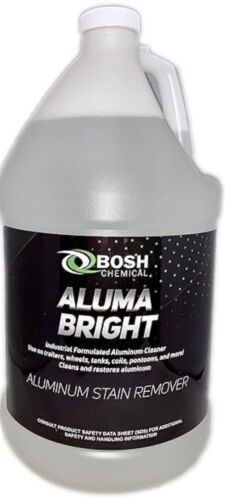
-----
Analysis of nitric-hydrofluoric aluminum etching mixture
Q. May I know how to monitor the consumption of nitric acid, hydrofluoric acid, and ammonium bifluoride when I use as the etching solution for aluminium material (AL6101-T63)
menmen loong- kl malaysia
May 12, 2021
⇩ Related postings, oldest first ⇩
Q. I'm working on aluminum acid etching using HF & HNO3. At the moment I'm using a hydrometer to check the concentration. However I'm looking for a more accurate titration technique to check concentrations of both HF and HNO3. Please help.
Nicholas Cheah- Malaysia
2000
A. Hydrometer is a very poor method of control since as the acid is expended, it is replaced with aluminum, copper and a few other alloying metals which tend to be heavier than the basic solution, so a very false reading. A plain old acid titration where you add both acids in the correct percent to make up for the spent acid may be adequate and is certainly a lot better.
For a much better control, use a selective ion electrode (fluoride) and test for the fluoride. Do a total acid titration. Subtract the HF number from the total and you get the nitric value. It is not perfect, but it is good and normally affordable. The electrode requires a pH meter capable of 0.1 mV accuracy. These are not cheap compared to garden variety meters. I used an Orion 901 and their probe with very good luck on titanium etch. They provided me with a couple of papers that I modified for my particular use. It used an alternate TISAB, not the normal one for the swamping agent.
- Navarre, Florida
A. I have some paperwork which suggests a two stage acid base titration.
Titrate a sample using sodium hydroxide 1N
[affil link] to pH 3.2 to get the Nitric acid. Then on the same sample continue to pH 5.8 to get the Hydrofluoric acid.
I have only used this method once but it seemed OK. Methyl orange
⇦ on
eBay or
Amazon [affil link]
and mehyl red
⇦ on
eBay &
Amazon [affil link]
indicators work at approximately the right endpoints if you want to do without pH meter.
You may need to change the concentration of Sodium Hydroxide for the second stage depending on the relative concentrations.
- Great Britain
2000
A. You can use an autotitrator to determine automatically the 2 equivalent points in a single sample. Multiple acids titration is quite common in the electronic chemical industry and most can be easily solved by autotitration. There is need for the use of colour indicators nor pH meters then. If you need further information, please feel free to write back.
Lin Yau Yeng- Singapore
2002
Q. Does anyone have suggestions on how to measure the concentrations of nitric acid and hydrofluoric acid in a mix ratio of 20% to 3%? I used the pH method, measuring the amount of 0.2 N sodium hydroxide required to bring the pH up to 3.2 and 5.8 to determine the respective amounts. The results looked accurate until the nitric acid concentration dropped low. At that point, the hydrofluoric acid concentration appeared to spike up (even though HF wasn't added). Perhaps this method works only at high nitric acid concentrations? Does anyone have an accurate method of measuring for all acid concentrations?
Keith Lew- San Francisco, California
2003
Q. Hello Keith:
Did anyone answer your question yet? I have kind of the same problems using HNO3/HF ranging concentrations and at this time it is difficult for me to detect fluorides at a minimum amount like 1%. Please advise if you found something that helps us.
- Mexico
2003
A. We have recently taken over the running of a lab and have been looking for an improved method of testing HF/Nitric solutions used to etch titanium parts.
We have inherited 2 methods which we're examining at the moment:
In the first an aliquot is taken, KNO3 and ice added, and titrated against NaOH to first EP. The fluoride is estimated with an ISE. However, we find with this method the fluoride detected decreases with increased levels of Ti, presumably due to [TiF6]3- formation.
In the second an aliquot is taken, KF, (COOK)2 and CH3OH added, heated to 80 °C and titrated against NaOH to first EP. The nitrate is determined by IC.
Both methods seem ok, but not great. We've also tried fluoride by IC, and this result doesn't seem to be too affected by dissolved Ti.
I hope this may help some people ...
Q. But I would also appreciate if anyone can shed light on why the reagents are added, or if anyone's got any experience using ISEs or ICs to measure fluoride in similar solutions.
Chris nattrass- nottm, notts, uk
A. This is possible if using an autotitrator. The big trick here is that you must use dried acetone ⇦ on eBay or Amazon [affil link] Flammable! as the solvent, not water. In water, the nitric and HF react with NaOH at the same rate. In acetone, the dissociation constants shift. I am unsure how the indicators will work in acetone, so someone give it a shot and see. The nitric acid dissociates at a pH of approximately 4 and the HF dissociates at a pH of approximately 10 in acetone. I used a Mettler-Toledo T50M with a DGi116 solvent pH probe and 1.0N NaOH [1N NaOH on Amazon [affil link] . I repeatably found the nitric concentration (first inflection point to pH 4) to be 29.2% and the HF concentration to be 1.8% (second inflection point to pH of about 10). Good luck and let me know if you can use the indicators.
Matt Eby- Columbus, Ohio
July 1, 2009
2005
Q. Need a Titration for Ammonium Bifluoride Casting Etch. We have a requirement for the original build of the tank but we do not have a method for control other than the etch rate? How can we assure our customers that we are maintaining a concentration of 7-9 oz/gal (50# per 100 gal)of Ammonium Bifluoride remainder Nitric Acid 42 Degree baumé
Stephen WoodOzark Mountain - Cuba, Missouri, USA
A. Stephen,
I had to set up a known standard of the nitric and bifluoride solution, then titrate for both acid-base and bifluoride. Bifluorides are determined using a titration with Thorium Nitrate in Total Ionic Strength Adjustment Buffer. I'll go through my old notes and give you the constants. I know that using a 5 ml sample and 0.1N Thorium Nitrate, I multiplied mls of titre times 0.636 to determine oz/gal NH4HF2.

Randall Fowler - Fowler Industrial Plating, LLC
Cleveland, Tennessee, USA
2005
A. Thorium nitrate titration is a reliable analysis method but ... it is radioactive so most labs don't use it for years already.

Sara Michaeli
Tel-Aviv-Yafo, Israel
2005
Q. How to check concentration of nitric acid with the help of hydrometer? Please give the help.
chandrasekaran.v sekar- CHENNAI, India
December 17, 2010
A. Hi Chandrasekaran. A hydrometer measures the specific gravity of a solution. Nitric acid is heavier than water, so if you have a solution with just nitric acid and water (and nothing else), and you know the temperature (because water expands with heat, affecting the specific gravity), it is possible to correlate the hydrometer's specific gravity reading to the nitric acid concentration via a simple table. You will find that table in Perry's Chemical Engineers Handbook
[adv: suggestions on
Amazon,
AbeBooks, or
eBay affil links]
or on-line at
handymath.com/cgi-bin/nitrictble2.cgi?submit=Entry
But this only works for initial makeup. A hydrometer will not work for ongoing analysis of etching solutions (or much else) because, as James Watts has explained, the specific gravity of the solution is also affected by the dissolved aluminum content and other dissolved materials, destroying the correlation. Please give the details of your situation. Thanks!
Regards,

Ted Mooney, P.E.
Striving to live Aloha
finishing.com - Pine Beach, New Jersey
Ted is available for instant help
or longer-term assistance.
Q. I'm working on aluminum acid etching using HF & HNO3 with Deionized water at ratio:
HF:HNO3:H2O = 3:20:77
Please advise how to determine the concentration for these acids above.
- Malaysia
October 25, 2013
![]() Hello cousin Tran. I can't help you technically, but as website curator I suggest ...
Hello cousin Tran. I can't help you technically, but as website curator I suggest ...
There has been an extensive discussion, suggesting specific titration procedures and analytical equipment -- please try to frame your question in terms of what has already been said, asking questions about what you didn't understand or explaining why you feel the suggestions may not be applicable to your situation. Otherwise it can look like you're asking people to do arithmetic for you, and they won't. Thanks!
Regards,

Ted Mooney, P.E.
Striving to live Aloha
finishing.com - Pine Beach, New Jersey
Ted is available for instant help
or longer-term assistance.
October 30, 2013
Determining nitrate concentration in HNO3/HF acid bath
September 30, 2015Q. I am trying to determine the nitrate concentration in a HNO3/HF acid bath. I am using an Ion Chromatograph. I also use a titration with NaOH to determine nitric acid concentration. The bath must be held to 10-15 oz/gal HNO3. We use 42 degrees baumé HNO3 in the tank and 49% HF. I need to develop a standard curve using 1000 ppm NO3 standard solution. I need assistance to determine the best curve to cover the range of concentration in the tank. Any assistance would be appreciated.
Todd RobertsLab Tech - Tullahoma, Tennessee USA
A. One can determine total acidity, then determine HNO3 conc. via titration. A 1.00 ml sample is added, with good stirring, to about 80 ml ice cold concentrated sulfuric acid. Then, one titrates, keeping the mixture cold with strong stirring, with freshly standardized 0.1N FeSO4 solution. The endpoint is a brown red color.
Or, if you like, you may determine F- via an ISE method, using the method of additions.
In either case, the concentration of each respective acid may be arrived at by arithmetic.

Dave Wichern
Consultant - The Bronx, New York
October 2, 2015
Q. Hello,
I am using a Nitric / Ammonium Bifluoride mixture ~(20%/3%) and for pickling Aluminum 5052. The intent is to increase the surface roughness of the base aluminum as much as possible and maintain weight loss between 0.5% and 1%.
1. Does anyone have a specific procedure for measuring the HNO3 and HF concentrations? I have seen a lot of information regarding this but would like a more specific procedure if available.
2. How much faster does the HF react than the HNO3? I know the fluorides attack the silicon and I believe deposit on the surface of the Aluminum. Trying to figure out what the ratio of the make-up solution should be for replenishment.
- Chicago, Illinois, USA
February 26, 2016
A. I have had success using a 0.1000 N cyclohexylamine in methanol [affil link]. I can determine both nitric and hydrofluoric acid simultaneously with an autotitrator. It is titrated in methanol with a pH electrode, a non-aqueous titration.
David PARKINSONHydrite Chemical - Milwaukee, Wisconsin USA
October 19, 2016
Multiple threads merged: please forgive chronology errors and repetition 🙂
Analysis method for nitric acid and ammonium bifluoride for etch bath
Q. Hello,
Could you please recommend an analysis method for determining the concentrations of these two materials, nitric acid and ammonium bifluoride used for the etching of A356?
I would need this for maintenance of the bath.
I would like to double check with you "100% Nitric Acid + 2 pounds per gallon ammonium bifluoride"?
My lab chemist was a bit alarmed from the quantities.
- Beit Nechemia Israel
June 3, 2018
A. Hello Gabriel,
A great place to look is the tech sheet for a product called MacDermid-Enthone Metex Etch Salts, prod #13051.
It's an ammonium bifluoride product that is intended to be used with or without Nitric acid, depending on your application, and it has analysis instructions for both (though the calculation for 'Etch Salts" may or may not be EXACTLY equivalent to ammonium bifluoride content).
I have an ancient wrinkly fax in my files and trying to find a link online I'm discovering that you need an account/pw to view...
I have my own minor tweaks to the methods; this is not *quite* what theirs is, but here ya go:
Here's the one for the ammonium bifluoride, and take it with a grain of salt (no pun intended!):
Start with 1mL bath solution (let any particulate settle before taking your aliquot).
Add a drop of phenolphthalein, and a splash of deionized water, then very carefully raise the pH to JUST pink (I use NaOH 0.1N
⇦ on
eBay or
Amazon [affil link]
for this so as not to overshoot) while swirling, stop, and put in enough drops of H2SO4 0.1N to JUST bring it back clear again.
Add some more DI water, about 75mL is plenty, and put on your stir plate.
Add 40mL Boric acid solution, saturated (I use 60g in 1L hot DI water, shake and cool, it keeps for a long time) and 40mL reagent alcohol (ethanol-methanol mix).
Add 8g Potassium chloride. Allow everything to dissolve and mix well.
Add methyl orange
⇦ on
eBay or
Amazon [affil link]
indicator (my least favorite indicator ever!!) and titrate to full salmon-pink with H2SO4 0.1N.
mL H2SO4 0.1N x 4.5 =g/L ammonium bifluoride AS METEX ETCH SALTS... On the old MSDS, it's listed as 'Fluoride ion, 100% by weight' so you are absolutely going to want to make an analytical standard from fresh ammonium bifluoride, run a calibration curve, and confirm your multiplier.
Also, as the metals load up in the bath, it becomes wildly inaccurate... have fun! :)
There's also a titration listed for nitric acid in the presence of the Etch Salts that basically has a small correction [subtractive] for the interference of the salts themselves. Other than that, it's a normal Nitric test:
10mL bath sample, few drops methyl red
⇦ on
eBay &
Amazon [affil link]
indicator (you could probably get away with phenolphthalein for this just fine), titrate with 1.0N NaOH to yellow if using MR or pink if using PTH.
Without the ammonium bifluoride correction, it's mL NaOH 1N x 7.06 = %vv as 42'Be or 67% Nitric acid. With the Etch Salts correction, it's (mL NaOH1N -(oz/gal etch salts x .131)) x 7.06= %vv as HNO3 67%.
We use the etch salts without Nitric to frost Aluminum (2xxx, 6xxx, 7xxx) prior to desmutting and then anodizing. I would actually recommend just getting a sample of MacDermid's product and trying that out, and then if it gives the results you are looking for, you can use their calculations with greater confidence.
Good luck!

Rachel Mackintosh
Lab Rat / WWTF - Greenfield MA
![]() Hi Rachel,
Hi Rachel,
Thank you very much for the detailed instructions, that was really appreciated.
Great dane ya got there, lovely dogs, had a pair of them, Guliver and Angelica, miss them a lot, take care.
- Beit Nechemia
June 5, 2018
June 4, 2020
Q. Please, is there a better method to determine the concentration of HF or HNO3 in a mixture of HF and HNO3?
Tosin JA- austin, Texas
? Hi Tosin. This discussion has been ongoing for 20 years now, with 23 previous responses offering many different methods. Please try to be explicit about exactly what you want in looking for "a better method" -- accurate to more decimal places, or whatever. Thanks.
Luck & Regards,

Ted Mooney, P.E. RET
Striving to live Aloha
finishing.com - Pine Beach, New Jersey
Ted is available for instant help
or longer-term assistance.
November 2021
Ed. note: Some other highly applicable threads:
- Topic 34536 "How to Do Ammonium Bifluoride Analysis"
- Topic 54154 "Need thorium nitrate or alternate analysis method for fluoride"

Nadcap Chemical Processing Auditor - PRI, traveling
Process Engineer / Chemist - Denver Metal Finishing, Colorado
Q, A, or Comment on THIS thread -or- Start a NEW Thread
